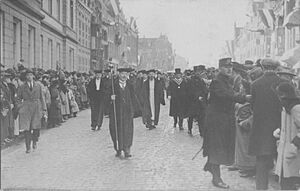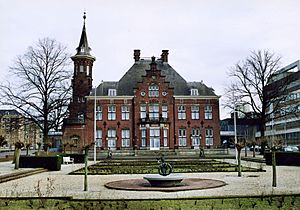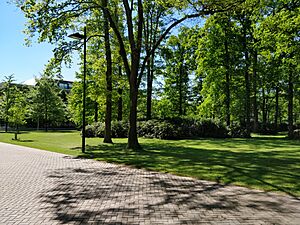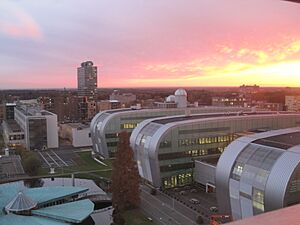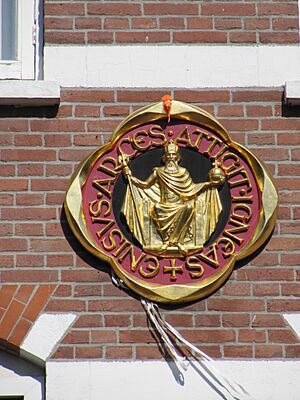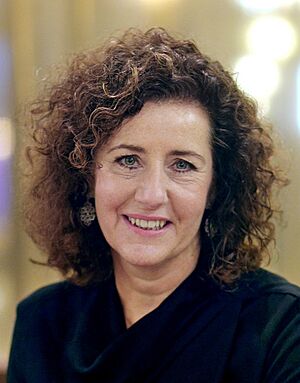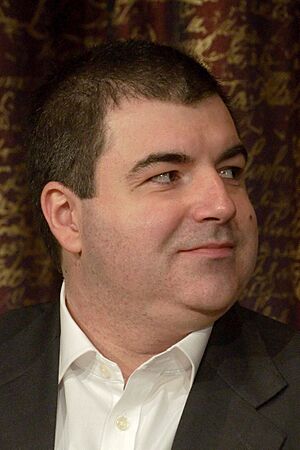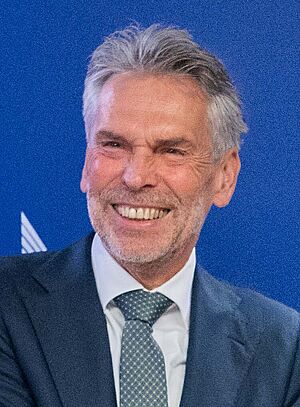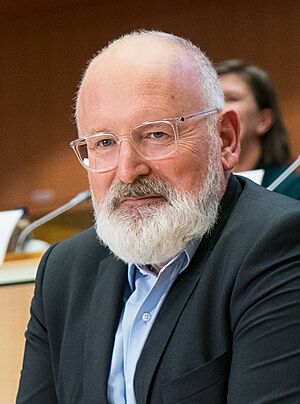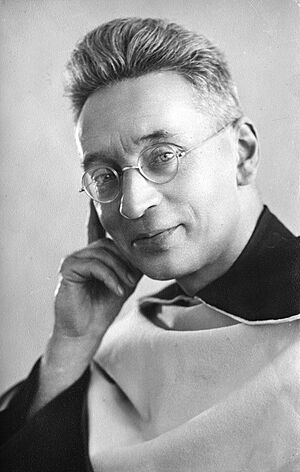Radboud University Nijmegen facts for kids
|
Radboud Universiteit
|
|
 |
|
|
Former name
|
Catholic University of Nijmegen (1923-2004) |
|---|---|
| Motto | In Dei Nomine Feliciter (Latin) |
|
Motto in English
|
Happily in God's name |
| Type | Public research university |
| Established | 17 October 1923 |
| President | Alexandra van Huffelen |
| Rector | José Sanders |
|
Academic staff
|
3,467 (2023) |
|
Administrative staff
|
2,735 (2021) |
| Students | 24,104 (October 2024) |
| Location |
,
Gelderland
,
Netherlands
|
| Campus | Urban |
| Colors | Red Impact |
| Affiliations | EUA IFCU Guild of European Research-Intensive Universities VSNU |
 |
|
Radboud University (often called RU) is a public university in Nijmegen, Netherlands. It is a place where students learn and researchers discover new things. Radboud University has seven main departments, called faculties, and more than 24,000 students.
The university started in 1923. It is often ranked among the top 150 universities in the world. For example, in 2020, it was ranked 105th globally. Radboud University is well-known for its strong research. In 2020, many new doctors (PhD degrees) graduated, and thousands of scientific articles were published. The university also works with other top universities around the world.
Many famous people have studied at Radboud University. This includes a Nobel Prize winner, Sir Konstantin Novoselov, and five prime ministers of the Netherlands, like the current prime minister Dick Schoof. Other notable alumni include important leaders in business and science.
Contents
- What is the Radboud University Coat of Arms?
- How Did Radboud University Start?
- What Can You Study at Radboud University?
- Exploring the Radboud University Campus
- Learning and Research at Radboud University
- Student Life at Radboud University
- Who are Some Famous Alumni?
- Who are Some Notable Faculty Members?
- See also
What is the Radboud University Coat of Arms?
The Radboud University coat of arms is like a special symbol or emblem. It was created when the university first opened. The bottom part of the shield shows the symbol of the Catholic Church in the Netherlands. The dove at the top represents the Holy Spirit.
Above the shield, there is a crown. This crown is a symbol of the Holy Roman Empire. It is there because Nijmegen was once home to the famous Frankish King Charlemagne. Below the coat of arms, you can read the university's motto: "In Dei Nomine Feliciter." This means "happily in God's name." The university uses this coat of arms on important documents, like graduation certificates.
How Did Radboud University Start?
The idea for a university in Nijmegen is very old. The first university there opened in 1655. It taught subjects like religion, medicine, and law. However, this first university closed around 1680. It faced problems like the plague and a war with France.
After many years, the current Radboud University opened in 1923. It was first called the Catholic University of Nijmegen. It was started by a group called the Saint Radboud Foundation. This group wanted to help Catholic thinkers in the Netherlands get better opportunities. At that time, Roman Catholics in the Netherlands often did not have many high-level jobs in government or science. Starting a university was a way to help them.
When the university first opened, all students automatically joined a student group called N.S.V. Carolus Magnus. This group was named after King Charlemagne. It was created to help students and organize events. Over time, students also formed smaller groups within this main organization.
The University During World War II
The university was doing well in its early years. But during World War II, it faced big challenges. Some important professors, like Robert Regout and Titus Brandsma, were sent to a concentration camp and died.
As the war continued, the university's freedom was limited. The German security service removed books they did not like from the library. Also, professors could only be hired if the Nazi government approved. These actions aimed to stop religious universities from existing.
In 1943, the situation became very difficult. The German occupiers demanded that all students sign a loyalty statement. If students did not sign, they could not continue their studies. They would also be forced to work in Germany. However, many students in Nijmegen refused to sign. A law student named Jozef van Hövelleven helped organize this resistance.
The university's leader, Bernard Hermesdorf, supported the students. He was the only university leader in the Netherlands who refused to give out the loyalty statements. Because of his brave refusal, the Germans became very angry. On May 5, 1943, they demanded that all students who had not signed report for forced labor. If they did not, their families would be punished.
Because of this, Bernard Hermesdorf had to close the university on April 11, 1943. Most students went into hiding across the Netherlands. A university leader named Bernard van Ogtrop helped them. He traveled around the country, sending letters and packages to keep their spirits up. Even though the university buildings were closed, the university continued to exist in the minds of its students.
After the War: 1945–2000
When the war ended in 1945, many university buildings were destroyed. But students slowly returned. Classes officially started again in March 1946. New buildings were needed. The university bought the Heyendaal estate, which became its new campus. This green area is close to the city center.
In 1951, the medical department was the first to move to Heyendaal. Other departments followed. By 1988, all departments were on the new campus. More students also started coming to the university. Student numbers grew from 3,000 in 1960 to 15,000 in 1980.
Between 1960 and 1975, there was a lot of student activity. The number of students grew, and they became more diverse. Many students wanted a more democratic student life. The old student group, Carolus Magnus, became less popular. Students did not like that joining it was mandatory. So, in 1966, Carolus Magnus changed. Students could then choose which groups to join. Many new student groups were formed in the 1980s and 1990s.
Radboud University Today: 2000–Present
In 2004, the university changed its name to Radboud University Nijmegen. It was named after Saint Radboud of Utrecht, a medieval bishop. This change showed that the university was becoming less focused on its religious ties.
There were some disagreements between the university and the bishops. In November 2020, the bishops removed the "Catholic" name from the university. This meant the university could no longer get church funding or call itself Roman Catholic. The university appealed this decision. In November 2022, a ruling from the Pope's office said that the bishops could remove the "Catholic" name from the university's leadership, but not from the university as a whole.
What Can You Study at Radboud University?
Radboud University has seven main departments, called faculties. These faculties offer many different study programs. You can study subjects like:
- Arts
- Law
- Medical Sciences
- Management
- Philosophy, Theology, and Religious Studies
- Science
- Social Sciences
Each faculty is a group of study programs, schools, and research centers. They all work together for education.
Exploring the Radboud University Campus
Radboud University is known for its beautiful, green campus. It is often called one of the most attractive campuses in the Netherlands. The campus is located in the Heyendaal estate in Nijmegen. It has all seven faculties for teaching and research.
The campus is also home to the Max Planck Institute for Psycholinguistics. This is a world-class research center that studies human language and communication.
A notable building on campus is the Heyendaal castle. It is next to the Radboud University Medical Center. This is a large hospital connected to the university's medical department. The Huygens Building, which houses the science faculty, is also nearby.
At the south end of the campus, you will find the Erasmus Tower. This building houses the Arts and Philosophy, Theology, and Religion faculties. The Erasmus Tower is next to the Radboud Sports Centre (RSC). The Elinor Ostrom building is home to the School of Management and political science.
The modern Maria Montessori building houses the Social Sciences faculty. The Grotius building is home to the Law faculty. In the very south of the campus, there is the historic Jesuit Berchmanianum monastery. This building is now used for university services and as an auditorium.
In 2017, a small SPAR supermarket opened in the Erasmus building. It provides snacks and other items for students. The university campus is also next to the HAN University of Applied Sciences. This is close to the Heyendaal train station. Buses often connect the university to Nijmegen Central Station and the city center.
Learning and Research at Radboud University
What Programs Does Radboud University Offer?
Radboud University has over 24,000 students. It offers about 100 different study programs. This includes about 50 bachelor's degrees and 50 master's degrees. As of April 2021, the university offers 34 international master's programs taught in English. Many bachelor's programs are also taught fully in English. These include American Studies, Artificial Intelligence, Biology, Chemistry, and Computing Science.
All master's programs at Radboud University are officially recognized. This means they meet high quality standards.
International Master's Programs
All master's programs taught in English are based on research. They are offered across various faculties, including Arts, Law, Social Sciences, Medical Sciences, Sciences, and Philosophy, Theology and Religious Studies.
What Kind of Research Happens at Radboud University?
Radboud University has several important research centers. These include the Donders Institute for Brain, Cognition and Behaviour, which studies the brain. Another is HFML-FELIX, which does research with strong magnetic fields.
Many faculty members have won the Spinoza Prize, which is a very important Dutch science award. Visiting professor Sir Andre Geim and former PhD student Sir Konstantin Novoselov won the 2010 Nobel Prize in Physics for their work on graphene.
How Does Radboud University Rank?
| University rankings | |
|---|---|
| Global – Overall | |
| ARWU World | 101–150 (2024) |
| QS World | 279 (2026) |
| THE World | =143 (2025) |
| USNWR Global | =117 (2025) |
Radboud University has been named the best broad university in the Netherlands for seven years in a row. Its physics department is considered excellent. For example, it helped create the first picture of a black hole.
The Law faculty is known for its research in business and law. It works closely with other famous universities like Bologna and Oxford. The European Law School and Notarial Law departments are considered the best in the Netherlands. The Political Sciences, Sociology, and Theology programs are also top in their fields.
What is the Radboud Excellence Initiative?
The Radboud Excellence Initiative helps attract talented researchers from all over the world to Radboud University. It also helps build strong connections with other universities globally. This program offers fellowships for promising researchers who have recently finished their doctorate. More experienced researchers can be nominated for a professorship.
Student Life at Radboud University
What Student Groups Can You Join?
Radboud University offers many different student groups. These include groups based on culture, politics, and special interests. There are also honor societies and social clubs.
| Student association | Date of establishment | Members | Type of Association |
|---|---|---|---|
| N.S.V. Carolus Magnus | February 1, 1928
(revival in 1973) |
600 | Traditional |
| N.S.R.V. Phocas | May 1, 1947 | 550 | Rowing-oriented |
| N.S.H.C. Apeliotes | October 8, 1987 | 500 | Field hockey-oriented |
| N.S.Z.V. De Loefbijter | February 23, 1967 | 75 | Sailing-oriented |
| A.E.G.E.E. Nijmegen | August 22, 1986 | 85 | International |
| N.S.N. (Navigators) | November 2, 1989 | 215 | Christian |
| V.G.S.N. Thesaurum Quaeritans | March 21, 1990 | 53 | Reformed (Liberated) |
| N.S.V. Ovum Novum | May 20, 1990 | 630 | Egalitarian |
| K.S.N. – Katholieke Studenten Nijmegen | August 21, 2000 | 23 | Catholic |
| A.S.V. Karpe Noktem | December 7, 2004 | 140 | Alternative |
| C.S.F.R. Quo Vadis | October 27, 2009 | 50 | Reformed |
| N.S.R.V. Obelix | May 1, 1970 | 100 | Rugby-oriented |
What are Study Associations?
Study associations are groups linked to specific degree programs. They are open to international students. These groups do not have special initiation rituals. They meet regularly for fun activities and study-related events. Examples include groups for computing science students (Thalia) and history students (GSV Excalibur).
What Publications Does the Campus Have?
Radboud University has its own independent media platform called Vox. It is for students and staff. Vox publishes daily news online and prints magazines several times a year. The paper magazine is free on campus. There is also an independent student magazine called Algemeen Nijmeegs Studentenblad (ANS), which comes out seven times a year.
What Sports Can Students Play?
The Radboud Sports Centre (RSC) offers many sports facilities. Students can use them seven days a week. There are over 80 different sports available. Radboud University also has more than 35 student sports associations. These include teams for baseball (Radboud Rangers), rugby (Obelix), hockey (Apelliotes), soccer (FC Kunde), rowing (Phocas), and sailing (De Loefbijter).
Who are Some Famous Alumni?
Many notable people have graduated from Radboud University. Here are a few:
Politics
- Dries van Agt – Former Prime Minister of the Netherlands
- Louis Beel – Former Prime Minister of the Netherlands
- Jo Cals – Former Prime Minister of the Netherlands
- Ingrid van Engelshoven – Former Dutch Minister of Education, Culture and Science
- Dick Schoof – Current Prime Minister of the Netherlands
- Frans Timmermans – Dutch politician and diplomat, former First Vice-President of the European Commission
Academics and Science
- Anna Akhmanova – Cell biologist and winner of the 2018 Spinoza Prize
- Sir Konstantin Novoselov – Discoverer of graphene, won the 2010 Nobel Prize in Physics
- Frans de Waal – Biologist known for his work on primate behavior
Business
- Marijn Emmanuel Dekkers – Former CEO of Bayer and Unilever
- Herna Verhagen – CEO of PostNL, named most influential Dutch woman in 2014
Sports
- Björn Kuipers – Famous football referee
- Koen Metsemakers – Rower, won a gold medal at the 2020 Summer Olympics
- Nelleke Penninx – Rower, won a silver medal at the 2000 Summer Olympics
- Annemarieke van Rumpt – Rower, won a bronze medal at the 2004 Summer Olympics
Literature and Arts
- Godfried Bomans – Popular Dutch writer, known for his children's fantasy novel "Eric in the Land of the Insects"
- Henri Nouwen – Catholic priest and writer, known for his book "The Return of the Prodigal Son"
Who are Some Notable Faculty Members?
Here is a partial list of notable faculty members at Radboud University:
- Titus Brandsma – Co-founder of the university, died in a concentration camp
- Joan Daemen – Cryptographer, helped develop AES and SHA-3
- Heino Falcke – Professor of radio astronomy, involved in the first black hole image
- Andre Geim – Physicist, joint winner of the 2010 Nobel Prize in Physics
- Mihai Netea – Physician, awarded the Spinoza Prize in 2016
See also
 In Spanish: Universidad Radboud de Nimega para niños
In Spanish: Universidad Radboud de Nimega para niños
- Hogeschool van Arnhem en Nijmegen, another university in Nijmegen
- List of early modern universities in Europe



